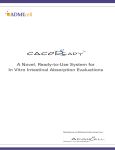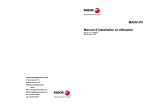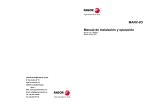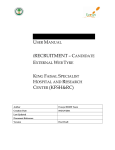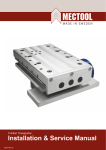Download CacoReady Frequently Asked Questions (FAQs)
Transcript
CacoReady® Frequently Asked Questions (FAQs) What is the composition of the CacoReady® Shipping Media? The CacoReady® shipping media is a proprietary reagent that becomes solid at room temperature and provides two functions: (a) stabilizes the Caco-2 cells during shipping and (b) preserves the integrity of the cells junctions. 2. What is the optimum time for liquidifying the CacoReady® shipping media? The optimal time for liquidifying the CacoReady® shipping media prior to the exchange with the fresh media is between 3 to 4 hours at 37C. Leaving the CacoReady® plates in the shipping media at 37C for more than 4 hours may compromise the cells junctions. 3. Can CacoReady® plates be tilted or kept at an angle during aspiration? Tilting or keeping the CacoReady® plates in an angle during aspiration is not recommended, as this action may damage the cells barrier integrity. 4. Which aspiration technique is recommended for washing the plates? The use of a manifold for aspiration is highly recommended. Please consult the “Instruction for Use” provided with the product manual. 5. Can LY (Lucifer Yellow) be performed on the same well after transport study? This is not recommended. Although it has been performed and has worked well. However, care must be taken not to disturb the Caco-2 cells barrier during aspiration and re-use. 6. Is Costar reservoir plate (Cat. No. #3395) absolutely necessary for CacoReady® (24 well) during media exchange? The Costar reservoir plates (Cat. No. #3395) are for use during the media exchange to help support the top plates (transwells). The plates with cat. No. #3326 can also be used for the same function; however, care must be taken not to damage the transwells. 7. Are there any data available on Caco-2 cells genomic expression profile? We have no data on the genomic expression profile. However, we have checked different barriers markers among passages: i.e., Lucifer Yellow, TEER, junctions proteins and PgP. 8. What cell passages are used for the production of CacoReady® plates? The manufacturing of CacoReady® plates are carried out using cells from passages 55 to 70. 9. Is PgP overexpressed at the passages used for manufacturing the CacoReady® plates? The PgP is well-expressed at the passages that are utilized for manufacturing of the CacoReady® plates compared to other passages used. Thus, it is not overexpressed, but is present along with certain other transporters. 10. What is the optimal pH for using the CacoReady® plates? pH ranges are 6.5 (apical) to 7.4 (basal). 1. Which compounds are recommended as 11. positive and negative controls for permeability studies? 12. What protein/material is recommended for use in preparation of cell culture medium? Any data available for the 2 hour incubation 13. with 5 mM D-glucose added to the transport buffer? How do you move from well to well without 14. allowing the electrodes to have contact with the air? Propanolol and Antipyrin can be used as the positive controls and LY and/or Manitol as the negative controls. Inactivated Calf serum should be used for preparation of the cell culture medium. Papps of reference compounds are: a. Digoxin 1.23x10-6 b. Colchicin: 1.15x10-6 It all depends on the equipment used for reading the Teer. In our case, the electrode does not read until it is inside the well and the read button is manually pressed. The user manual recommends that the button should not be pressed while the electrode is in contact with air. Only press the button when the electrode is inside the well. The CacoReady® has not been validated with PET membrane. The main difference between the polyester membrane and polycarbonate membrane is the density of the pores. 15. Has CacoReady® product been validated with polyester (PET) membrane? Nominal Pore Density: Polycarbonate (PC) = 1x108 pores/cm2 Polyester (PET) = 4x106 pores/cm2


